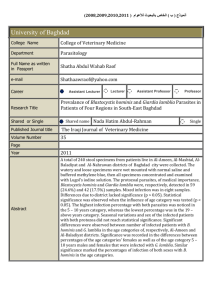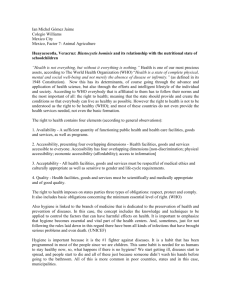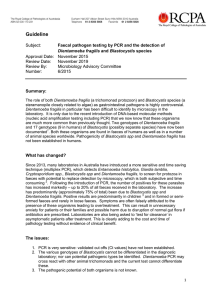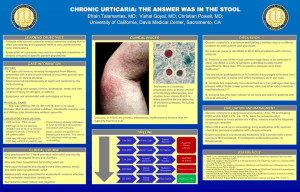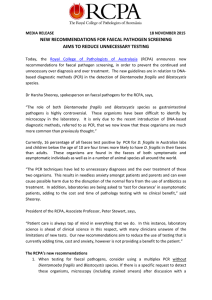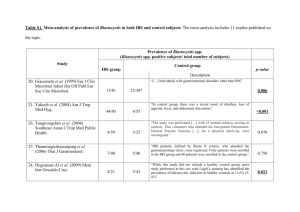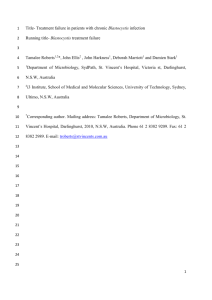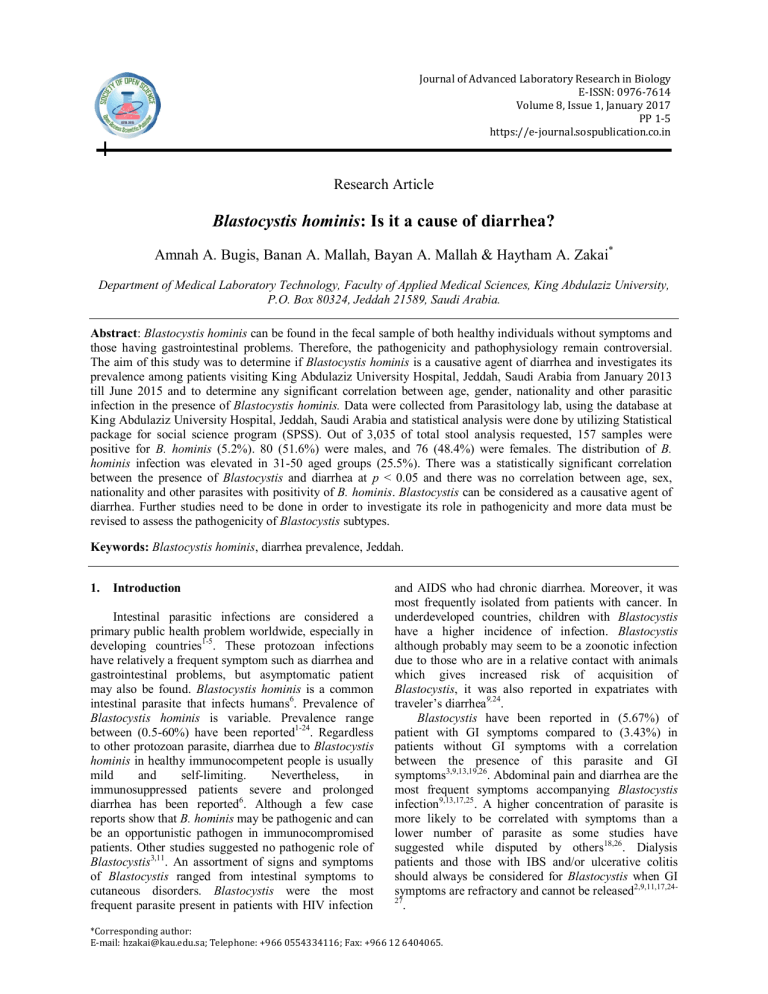
Journal of Advanced Laboratory Research in Biology E-ISSN: 0976-7614 Volume 8, Issue 1, January 2017 PP 1-5 https://e-journal.sospublication.co.in Research Article Blastocystis hominis: Is it a cause of diarrhea? Amnah A. Bugis, Banan A. Mallah, Bayan A. Mallah & Haytham A. Zakai* Department of Medical Laboratory Technology, Faculty of Applied Medical Sciences, King Abdulaziz University, P.O. Box 80324, Jeddah 21589, Saudi Arabia. Abstract: Blastocystis hominis can be found in the fecal sample of both healthy individuals without symptoms and those having gastrointestinal problems. Therefore, the pathogenicity and pathophysiology remain controversial. The aim of this study was to determine if Blastocystis hominis is a causative agent of diarrhea and investigates its prevalence among patients visiting King Abdulaziz University Hospital, Jeddah, Saudi Arabia from January 2013 till June 2015 and to determine any significant correlation between age, gender, nationality and other parasitic infection in the presence of Blastocystis hominis. Data were collected from Parasitology lab, using the database at King Abdulaziz University Hospital, Jeddah, Saudi Arabia and statistical analysis were done by utilizing Statistical package for social science program (SPSS). Out of 3,035 of total stool analysis requested, 157 samples were positive for B. hominis (5.2%). 80 (51.6%) were males, and 76 (48.4%) were females. The distribution of B. hominis infection was elevated in 31-50 aged groups (25.5%). There was a statistically significant correlation between the presence of Blastocystis and diarrhea at p < 0.05 and there was no correlation between age, sex, nationality and other parasites with positivity of B. hominis. Blastocystis can be considered as a causative agent of diarrhea. Further studies need to be done in order to investigate its role in pathogenicity and more data must be revised to assess the pathogenicity of Blastocystis subtypes. Keywords: Blastocystis hominis, diarrhea prevalence, Jeddah. 1. Introduction Intestinal parasitic infections are considered a primary public health problem worldwide, especially in developing countries1-5. These protozoan infections have relatively a frequent symptom such as diarrhea and gastrointestinal problems, but asymptomatic patient may also be found. Blastocystis hominis is a common intestinal parasite that infects humans6. Prevalence of Blastocystis hominis is variable. Prevalence range between (0.5-60%) have been reported1-24. Regardless to other protozoan parasite, diarrhea due to Blastocystis hominis in healthy immunocompetent people is usually mild and self-limiting. Nevertheless, in immunosuppressed patients severe and prolonged diarrhea has been reported6. Although a few case reports show that B. hominis may be pathogenic and can be an opportunistic pathogen in immunocompromised patients. Other studies suggested no pathogenic role of Blastocystis3,11. An assortment of signs and symptoms of Blastocystis ranged from intestinal symptoms to cutaneous disorders. Blastocystis were the most frequent parasite present in patients with HIV infection and AIDS who had chronic diarrhea. Moreover, it was most frequently isolated from patients with cancer. In underdeveloped countries, children with Blastocystis have a higher incidence of infection. Blastocystis although probably may seem to be a zoonotic infection due to those who are in a relative contact with animals which gives increased risk of acquisition of Blastocystis, it was also reported in expatriates with traveler’s diarrhea9,24. Blastocystis have been reported in (5.67%) of patient with GI symptoms compared to (3.43%) in patients without GI symptoms with a correlation between the presence of this parasite and GI symptoms3,9,13,19,26. Abdominal pain and diarrhea are the most frequent symptoms accompanying Blastocystis infection9,13,17,25. A higher concentration of parasite is more likely to be correlated with symptoms than a lower number of parasite as some studies have suggested while disputed by others18,26. Dialysis patients and those with IBS and/or ulcerative colitis should always be considered for Blastocystis when GI symptoms are refractory and cannot be released2,9,11,17,2427 . *Corresponding author: E-mail: hzakai@kau.edu.sa; Telephone: +966 0554334116; Fax: +966 12 6404065. Blastocystis and Diarrhea There are at least 13 subtypes of Blastocystis. Some are recovered from human stool while others were recovered from animals8,11,13,16,26,28-31. Pathogenicity comparison between subtypes is still controversial. This study was aimed to determine if Blastocystis hominis is a causative agent of diarrhea and investigate its prevalence among patients visiting King Abdulaziz University Hospital, Jeddah, Saudi Arabia from January 2013 till June 2015 and to detriment any significant correlation between age, gender, nationality and other parasitic infection with the presence of Blastocystis hominis. 2. Zakai et al was no correlation between age, sex, nationality and other parasites with positivity of B. hominis. Table 1. Age groups of patients positive for Blastocystis hominis. Age group 0-5 6-15 16-30 31-50 51-70 Percentage 1.3% 15.3% 24.2% 25.5% 18.5% Table 2. Nationalities of patients with Blastocystis hominis positive samples. Material and method Nationality Saudi Yamani Indian Palestinian Pakistani Egyptian Philippine Sudanese Ethiopian Syrian Somalian Others 2.1 Sample collection This was a retrospective study that included data collected and annualized between January 2013 till June 2015 from Parasitology Laboratory at King Abdulaziz University Hospital, Jeddah, Saudi Arabia. Overall, 3,035 total stool analysis were requested between January 2013 till June 2015. Of these, 157 samples were positive for B. hominis. Other data variables taken into consideration were age, sex, nationality, occult blood and the presence of other parasite. 2.2 Stool analysis Stool samples were collected in a clean and dry screw top container after giving the instructions of collections to the patient. Samples were analysed using Biosepar® ParasiTrap diagnostic system for detection of parasites in feaces according to the manufacturer instructions32. 2.3 Occult blood For hidden blood in gastrointestinal bleeding of GI disorders, HEMOSURE® test were used for qualitative determination of fecal occult blood according to the manufacturer instructions33. 2.4 Data processing and statistical analysis Statistical package for social science software (version 16) and Microsoft Excel were used for data processing and statistical analysis. 3. Frequency 2 24 38 40 29 Result One hundred and fifty-seven (5.2%) samples were positive of B. hominis as described above. Positive samples were seen in different age groups as shown in Table 1. Among 157 positive B. hominis samples, 51.6% of samples were from male patients. Positive samples were from different nationalities as shown in Table 2. Other parasites detected in positive samples and their frequencies are shown in Table 3. Occult blood was positive in few samples. There was a statistically significant correlation between the presence of Blastocystis and diarrhea at p < 0.05. However, there J. Adv. Lab. Res. Biol. Frequency 53 30 16 9 8 7 7 6 4 4 4 9 Table 3. Other parasites detected in Blastocystis hominis positive samples. Other parasites Entamoeba coli cyst Entamoeba histolytica cyst Endolimax nana cyst Giardia lamblia cyst Trichuris trichiura ova 4. Frequency 5 3 2 1 1 Discussion Intestinal parasitic infections are considered as primary public health problem worldwide5. Diarrhea is the most frequent symptom for intestinal parasitic infections, but asymptomatic individual can also be found. Blastocystis hominis is a common intestinal parasite that is found in human fecal samples and has been identified recently in patients with diarrhea, although its role remains controversial due to its presence also in healthy individual2. Among different geographic regions, the diversity of the prevalence rate of Blastocystis hominis has been reported. The reported prevalence ranged (2-50%)3,9. While other studies revealed a range between (0.560%)4,11-13,16,23. The present study shows a prevalence of (5.2%) which is within the range of previous studies. Different factors may contribute to the prevalence of intestinal parasitic infections such as sanitation and hygiene. Although, developed countries have a lower prevalence compared to developing countries taking the 2 Blastocystis and Diarrhea variation in different regions of the same country into consideration9. Differences in the diagnostic methods used properly, may lead to a significant difference that can be related to the epidemiological setting in reported prevalence. In this regard, the true prevalence of the infection is not known. Therefore, result does not necessarily reflect the population’s real prevalence, which is considered one of the limitations of the study. Blastocystis hominis is considered as the most frequently identified parasite in human stool specimens18. There was no statistically significant correlation between nationality and B. hominis infection. This may be due to the subjectivity of data collection of this study. Therefore, further studies need to be conducted on a wide range to compare the frequency of B. hominis infection with other countries. Moreover, there was no statistically significant correlation between age and B. hominis infection. This is an agreement with other studies6,16,35. However, epidemiological and diagnostic features of Blastocystis infection in symptomatic patients in some studies showed a statistically significant higher frequency of Blastocystis infection among 20-29 years group compared to other age groups (χ2: 13.68, p = 0.03)13 while in this study Blastocystis hominis was predominantly between 31-50 age group. This difference could be due to different lifestyle and hygiene, as well as the specificity of samples that was collected from a hospital, included pediatric and young patients with gastrointestinal symptoms and (15.24%) of these samples n=94 were positive for Blastocystis13. Another study observed the distribution of B. hominis infection was high (34.9%) in 7-13 aged children (χ2 = 306.8; p = 0.001)1. In contracts to another study which was highly significant among 0-19 age group among other age groups (p = 0.039)36. On the other hand, different study had observed that age was significantly correlated with discrete subtypes with those who had ST1 being younger (27 years) compared to ST3, ST4 and ST7 median ages (60, 54 and 46 years, respectively)36. According to gender, results indicate that there was no statistically significant correlation with B. hominis infection and this was in agreement with others3,6,9,11,15,19,36. Moreover, our results were in disagreement with a study that observed the relation between Blastocystis which occurs 2.34 times more frequently in subjects with IBS than in non IBS subjects (p > 0.01). The difference only in males was significant by comparing the prevalence of Blastocystis within male and female subgroups either with or without IBS (36.8% for IBS males’ vs 4.8% for control males) which was confirmed by the multivariate analysis26. With respect to the association of Blastocystis with other parasites, two cases were described with acute dysenteric diarrhea concomitantly with E. histolytica in one patient and G. duodenalis in the other2. On the other hand, and among Iranian population study, B. hominis was mostly found with E. coli in control group J. Adv. Lab. Res. Biol. Zakai et al and G. lamblia in case group while in other 21 patients B. hominis was detected alone without other parasites (55%). However, they found that there was no significant difference in the distribution of B. hominis cohabitation with other intestinal parasites in case compared to control group3. Even though there were few other parasites presented with B. hominis, our result showed that there was no significant correlation. This study showed a statistically significant correlation between the presence of Blastocystis and diarrhea (p < 0.05). This is in agreement with other studies examining the correlation between the presence of B. hominis, diarrhea, and abdominal pain9,13,16,24,26. In conclusion, the role of Blastocystis hominis has not been obviously defined. However, Blastocystis should be taken into consideration, as a causative agent of human disease, particularly when the parasite is present in enormous numbers in fecal specimens while absence of other recognized pathogens. The question of whether there are other factors involve the parasite in its capability to be opportunistic in immunocompromised and immunocompetent individuals has not yet been clearly countered. Blastocystis associated symptoms and its ability to produce clinically significant disease remain unexplained. Genetic variability has been notified to play role in the pathogenicity of Blastocystis so molecular field should be taken into consideration to determine the source and route of infection. References [1]. Zakai, H., Abunar, A., & Khoudari, A. (2014). Intestinal parasitic infections among the household staff working in Saudi family houses Jeddah, Saudi Arabia. Journal of Advanced Laboratory Research in Biology, 5(2): 18-20. [2]. Hawash, Y.A., Dorgham, L., Amir, E.M. & Sharaf, O.F. (2015). Prevalence of intestinal protozoa among Saudi patients with chronic renal failure: a case-control study. Journal of Tropical Medicine, Article ID 563478, 9 pages, https://doi.org/10.1155/2015/563478. [3]. Rostami Nejad, M., Nazemalhosseini Mojarad, E., Dabiri, H., Nochi, Z., Pourhoseingholi, M.A., Sahebekhtiari, N., Habibi, M. & Zali, M.R. (2010). A case-control study of Blastocystis hominis among Iranian population. East African Journal of Public Health, 7(1): 103-106. [4]. Rajamanikam, A. & Govind, S.K. (2013). Amoebic forms of Blastocystis spp. - Evidence for a pathogenic role. Parasit. Vectors, 6(1): 295. doi: 10.1186/1756-3305-6-295. [5]. Zaglool, D., Khodari, Y. & Farooq, M. (2012) Blastocystis hominis and allergic skin diseases; a single centre experience. Journal of Health Sciences, 2(1): 66 69. doi: 10.17532/jhsci.2012.66. [6]. Yakoob, J., Jafri, W., Beg, M.A., Abbas, Z., Naz, S., Islam, M. & Khan, R. (2010). Blastocystis 3 Blastocystis and Diarrhea [7]. [8]. [9]. [10]. [11]. [12]. [13]. [14]. [15]. [16]. hominis and Dientamoeba fragilis in patients fulfilling irritable bowel syndrome criteria. Parasitol Res., 107(3): 679-684. doi: 10.1007/s00436-010-1918-7. Hayashi, M., Inamori, M., Goto, K., Akiyama, T., Fujita, K., Ikeda, I., Fujisawa, T., Takahashi, H., Yoneda, M., Hara, K., Abe, Y., Kirikoshi, H., Kubota, K., Saito, S., Ueno, N., Nakajima, A., Hamada, Y., Fukutomi, H. & Satsuta, H. (2006). Blastocystis hominis infection in patient with regular dialysis. Journal of Gastroenterology, 41(6): 605. doi: 10.1007/s00535-006-1817-y. Stensvold, C.R., Christiansen, D.B., Olsen, K.E., & Nielsen, H.V. (2011). Blastocystis sp. subtype 4 is common in Danish Blastocystis-positive patients presenting with acute diarrhea. The American Journal of Tropical Medicine and Hygiene, 84(6): 883-885. Beyhan, Y.E., Yilmaz, H., Cengiz, Z.T. & Ekici, A. (2015). Clinical significance and prevalence of Blastocystis hominis in Van, Turkey. Saudi Medical Journal, 36(9): 1118-1121. Jones, M.S., Ganac, R.D., Hiser, G., Hudson, N.R., Le, A. & Whipps, C.M. (2008). Detection of Blastocystis from stool samples using real-time PCR. Parasitology Research, 103(3): 551-557. doi: 10.1007/s00436-008-1006-4. Bart, A., Wentink-Bonnema, E.M., Gilis, H., Verhaar, N., Wassenaar, C.J., van Vugt, M., Goorhuis, A. & van Gool, T. (2013). Diagnosis and subtype analysis of Blastocystis sp. in 442 patients in a hospital setting in the Netherlands. BMC Infectious Diseases, 13: 389. doi: 10.1186/1471-2334-13-389. Chan, K.H., Chandramathi, S., Suresh, K., Chua, K.H. & Kuppusamy, U.R. (2012). Effects of symptomatic and asymptomatic isolates of Blastocystis hominis on colorectal cancer cell line, HCT116. Parasitology Research, 110(6): 24752480. doi: 10.1007/s00436-011-2788-3. Dagci, H., Kurt, Ö., Demirel, M., Mandiracioglu, A., Aydemir, S., Saz, U., Bart, A. & VAN Gool, T. (2014). Epidemiological and diagnostic features of Blastocystis infection in symptomatic patients in Izmir province, Turkey. Iranian Journal of Parasitology, 9(4): 519-529. Leelayoova, S., Taamasri, P., Rangsin, R., Naaglor, T., Thathaisong, U. & Mungthin, M. (2002). In-vitro cultivation: a sensitive method for detecting Blastocystis hominis. Annals of Tropical Medicine and Parasitology, 96(8): 803-807. Whipps, C.M., Boorom, K., Bermudez, L.E. & Kent, M.L. (2010). Molecular characterization of Blastocystis species in Oregon identifies multiple subtypes. Parasitology Research, 106(4): 827832. doi: 10.1007/s00436-010-1739-8. El Safadi, D., Meloni, D., Poirier, P., Osman, M., Cian, A., Gaayeb, L., Wawrzyniak, I., Delbac, F., El Alaoui, H., Delhaes, L., Dei-Cas, E., Mallat, J. Adv. Lab. Res. Biol. Zakai et al [17]. [18]. [19]. [20]. [21]. [22]. [23]. [24]. [25]. [26]. H., Dabboussi, F., Hamze, M. & Viscogliosi, E. (2013). Molecular epidemiology of Blastocystis in Lebanon and correlation between subtype 1 and gastrointestinal symptoms. The American Journal of Tropical Medicine and Hygiene, 88(6): 12031206. doi: 10.4269/ajtmh. Leder, K., Hellard, M.E., Sinclair, M.I., Fairley, C.K. & Wolfe, R. (2005). No correlation between clinical symptoms and Blastocystis hominis in immunocompetent individuals. Journal of Gastroenterology and Hepatology, 20: 13901394. doi:10.1111/j.1440-1746.2005.03868.x. O'Gorman, M.A., Orenstein, S.R., Proujansky, R., Wadowsky, R.M., Putnam, P.E. & Kocoshis, S.A. (1993). Prevalence and characteristics of Blastocystis hominis infection in children. Clinical Pediatrics, 32(2): 91-96. Al-Megrin, W.A. (2010). Intestinal parasites infection among immunocompromised patients in Riyadh, Saudi Arabia. Pakistan Journal of Biological Sciences, 13(8): 390-394. Al-Binali, A.M., Bello, C.S., El-Shewy, K. & Abdulla, S.E. (2006). The prevalence of parasites in commonly used leafy vegetables in South Western, Saudi Arabia. Saudi Medical Journal, 27(5): 613-616. Khan, Z.A. & Alkhalife, I.S. (2005). Prevalence of Blastocystis hominis among "healthy" food handlers in Dammam, Saudi Arabia. Journal of the Egyptian Society of Parasitology, 35(2): 395401. Amin, A.M. (1997). Blastocystis hominis among apparently healthy food handlers in Jeddah, Saudi Arabia. Journal of the Egyptian Society of Parasitology, 27(3): 817-823. Duda, A., Kosik-Bogacka, D., LanochaArendarczyk, N., Kołodziejczyk, L. & Lanocha, A. (2015). The prevalence of Blastocystis hominis and other protozoan parasites in soldiers returning from peacekeeping missions. The American Journal of Tropical Medicine and Hygiene, 92(4): 805-806. doi: 10.4269/ajtmh.14-0344. Coyle, C.M., Varughese, J., Weiss, L.M. & Tanowitz, H.B. (2012). Blastocystis: to treat or not to treat. Clinical Infectious Diseases, 54(1): 105110. doi: 10.1093/cid/cir810. Tai, W.P., Hu, P.J., Wu, J. & Lin, X.C. (2011). Six ulcerative colitis patients with refractory symptoms co-infective with Blastocystis hominis in China. Parasitology Research, 108(5): 12071210. doi: 10.1007/s00436-010-2164-8. Nourrisson, C., Scanzi, J., Pereira, B., NkoudMongo, C., Wawrzyniak, I., Cian, A., Viscogliosi, E., Livrelli, V., Delbac, F., Dapoigny, M. & Poirier, P. (2014). Blastocystis is associated with decrease of fecal microbiota protective bacteria: comparative analysis between patients with irritable bowel syndrome and control 4 Blastocystis and Diarrhea [27]. [28]. [29]. [30]. [31]. subjects. PLoS One, 9(11): e111868. doi: 10.1371/journal.pone.0111868. Matiut, D.S. & Hritcu, L. (2015). The pathogenic role of Blastocystis isolated from patients with irritable bowel syndrome and colitis from Iasi, Romania. Acta Parasitologica, 60(1): 116-123. doi: 10.1515/ap-2015-0015. Dunn, L.A., Tan, K.S., Vanelle, P., Juspin, T., Crozet, M.D., Terme, T., Upcroft, P. & Upcroft, J.A. (2012). Development of metronidazoleresistant lines of Blastocystis sp. Parasitology Research, 111(1): 441-450. doi: 10.1007/s00436012-2860-7. Poirier, P., Meloni, D., Nourrisson, C., Wawrzyniak, I., Viscogliosi, E., Livrelli, V. & Delbac, F. (2014). Molecular subtyping of Blastocystis spp. using a new rDNA marker from the mitochondria-like organelle genome. Parasitology, 141(5): 670-681. doi: 10.1017/S0031182013001996. Abu-Madi, M., Aly, M., Behnke, J.M., Clark, C.G. & Balkhy, H. (2015). The distribution of Blastocystis subtypes in isolates from Qatar. Parasites and Vectors, 8: 465. doi: 10.1186/s13071-015-1071-3. Lee, L.I., Chye, T.T., Karmacharya, B.M. & Govind, S.K. (2012). Blastocystis sp.: waterborne J. Adv. Lab. Res. Biol. Zakai et al [32]. [33]. [34]. [35]. [36]. zoonotic organism, a possibility? Parasites and Vectors, 5: 130. doi: 10.1186/1756-3305-5-130. BIOSEPAR - Diagnostik für die Zukunft [Internet] [2016]. Biosepar de, Available from: https://www.biosepar.de/downloads. [Accessed 23/04/2016]. Our Products – Hemosure, Inc. [Internet] [2016]. Hemosure Inc. Available from: http://hemosure.com/hospitallaboratory/products/. [Accessed 23/04/2016]. Koshak, E.A. and Zakai, H.A. (2003). A spectrum of pathogenic and non-pathogenic intestinal parasites in pre-employment medical check-up for workers and their families. Journal of Family and Community Medicine, 10(1): 47-53. Ozçakir, O., Güreser, S., Ergüven, S., Yilmaz, Y.A., Topaloğlu, R., & Hasçelik, G. (2007). Characteristics of Blastocystis hominis infection in a Turkish university hospital. Turkiye parazitolojii dergisi, 31(4): 277-282. Stensvold, C.R., Lewis, H.C., Hammerum, A.M., Porsbo, L.J., Nielsen, S.S., Olsen, K.E., Arendrup, M.C., Nielsen, H.V. & Mølbak, K. (2009). Blastocystis: unravelling potential risk factors and clinical significance of a common but neglected parasite. Epidemiology and Infection, 137(11): 1655-1663. doi: 10.1017/S0950268809002672. 5
